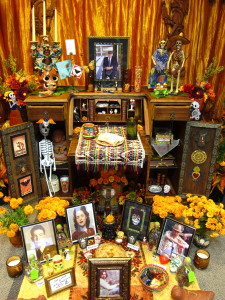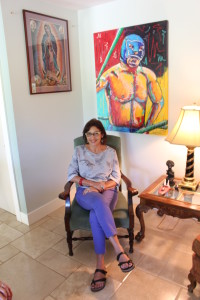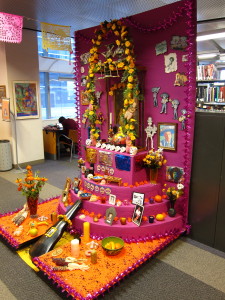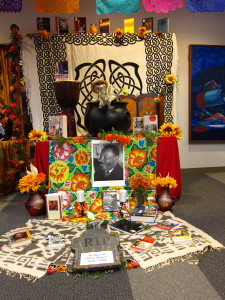Lara Medina, an expert on Chicano and indigenous American religious practices and spirituality, explains the history of Mesoamerica’s Dia de los Muertos and talks about living the nepantla life and the creativity that blurry boundaries produce.
By Sharon Simonson

Don’t call Dia de los Muertos the Mexican Halloween, begs Lara Medina.
The 62-year-old autora y professora of Chicano and Chicana religious history at California State University, Northridge, has watched and studied the holiday and its U.S. incarnation since the early 1970s when visiting Mexican artists traveling in Los Angeles and San Francisco staged small-scale celebrations as a solace to the deaths of the Vietnam War.
What began as a sacred pre-Colombian familial observance by Mesoamericans has evolved into its current manifestations: SeeCalifornia.com, The Ultimate Vacation Guide, lists 55 public Day of the Dead celebrations statewide in art centers, community centers, museums, streets and more than one cemetery, this month and early next; San Francisco and San Jose have at least five celebrations between them. “It is becoming what you could say is an American tradition,” Medina said.
In that assimilation, she sees the creep of commercialism and the loss of understanding of the celebration’s basis. Altars are decorated with cheap mass-produced goods; people wear skeleton costumes and colorful face paint to mimic the aspect of a skinless skull. “The integrity of the celebration is the artisanship,” she said. “It is a time to honor and communicate with our dead. (Among indigenous Indians) it was seen as a very privileged time when the divide between the physical and spiritual worlds dissolved, and the spirits can return for all that is laid out for them.” The fruits of their harvests were their offerings.

The practice acknowledged and thanked ancestors for the skills and learning they had shared to allow their living descendants to grow those foods and thrive. People gathered for intimate family observations — and still do in rural Mexico, she said. In urban Mexico, it has become more as it is in the United States.
Mexico has been the largest source of new immigrants to California and other U.S. border states since the 1930s, according to a Pew Research Center study published Sept. 28 of modern immigration to the United States. In the 1970s, Mexican immigrants began to settle beyond the border-states (Texas, New Mexico, Arizona and California), and by the 1980s, Mexicans had become the nation’s largest immigrant group. The U.S. Hispanic population has grown from 4 percent of the total in 1965 to 18 percent today, from eight million people to nearly 57 million.
The expanding popularity of Dia de los Muertos (Day of the Dead) grows from that rising U.S. Hispanic population, greater media and press attention and the nature of the holiday itself, Medina said: “It’s also appealing to non-Latinos. It allows us to talk about our dead and to teach young people about family members. People from various backgrounds are embracing the tradition because it works for them.”

Hispanic millennials (those born in the last 20 years of the 20th century, roughly) along with a smattering of their Asian and white contemporaries now fill her CSUN classes including “Religion and Spirituality in Chicano Communities” and “Healing Traditions in Chicano/Chicana Communities.” Many of her students describe themselves as “spiritual,” and Hispanic students often are versed in the traditions of the Catholic Church. But across the board, they shun institutional religion. “They are called ‘nones,’” Medina said. “Among my students who claim that identity — spiritual but not religious — often they can’t articulate what that means.”
She, too, has moved away from the Catholic Church, Medina said, and has come to embrace what she calls the “nepantla” life. A word from the Mesoamerican language Nahuatl, variations of which are still spoken by 1.6 million people in Southern Mexico, according to AboutWorldLanguages.com, nepantla identifies a space in the middle of others, such as the middle of the earth. In the 1980s, American cultural theorist Gloria Anzaldua recast the word’s meaning to signify a theoretical space, in ![]() particular the unsettled place that Mexican-Americans occupy between — but never within — the Mexican and American cultures and societies. “It had tremendous impact on Chicano theory and Chicano and Chicana studies. It created a framework of thought that had not been there,” Medina said. For her, nepantla is “a space of great creativity.”
particular the unsettled place that Mexican-Americans occupy between — but never within — the Mexican and American cultures and societies. “It had tremendous impact on Chicano theory and Chicano and Chicana studies. It created a framework of thought that had not been there,” Medina said. For her, nepantla is “a space of great creativity.”

“I’m not saying there is no chaos, that you don’t feel like you don’t belong. But that is where amazing cultural expressions and theories emerge, and self-understanding and new cultures are born,” Medina said.
The rate of Mexican immigration to the United States is slowing. The Pew center anticipates that Asians will overcome Hispanics as the largest immigrant group in the country by 2055. Hispanics will remain 31 percent of the immigrant population in 2065, Asians 38 percent. Whites will be 20 percent, blacks 9 percent.